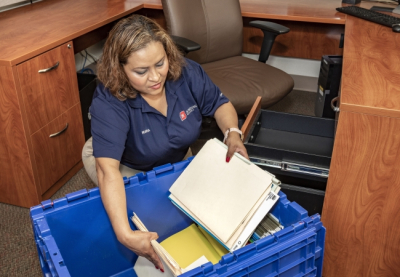Proper labeling is the most important part of the move preparation. The labels tell the move team what should be moved and the proper placement of each item at your new location. Below are 5 office packing/labeling tips for your next move.
Tip #1: Labeling
All items moving must be labeled (i.e. furniture, computers, moving boxes, chairs, pictures, trash cans, floor mats, etc.). Each office, cubicle/workstation, work room, and open area will be assigned a unique move number by your mover. This is to ensure all items are moved according to the floor plan. The move number should be written in the room section of the label (please double check you are writing the correct move number based on the color-coded move floor plan).
The piece section of the label should be used along with the room placards. When moving multiple file cabinets, bookcases or any other identical furniture items, a specific letter should be assigned to each piece of furniture. For example: 4A, 4B, 4C – This will allow for a set of files to be placed in a specific order.
Tip #2: Labeling pictures and whiteboards
Pictures and whiteboards should be labeled and left hanging on walls or stacked against the wall. These items will be packed and moved either in picture carts or commercial bins, using appropriate moving and packing materials. Small pictures that can fit into a crate should be bubble wrapped and placed in a crate, ensuring the use of proper moving and packing materials for added protection during the move.
Tip #3: Labeling your filing cabinets, bookcases, shelving
- Two (2) drawer metal lateral filing cabinets (aka pedestals) can generally be moved full without emptying the contents.
- Four (4) or 5 drawer metal lateral filing cabinets may be moved full using the Spider Crane® (if the filing cabinet brand qualifies). Otherwise, we highly recommend you pack the cabinets to avoid damage during the move process.
- Wood filing cabinets must be emptied prior to the move.
- If you have a push lock on your furniture but no key, please wrap tape around the push lock to prevent it from accidentally locking during the move.
- Storage cabinets must be completely emptied prior to moving.
- Bookcases must be emptied before moving. For bookcases that have removable shelves, please remove and label each shelf, and place them on the floor. Also label the top of the bookcase and place shelf pegs in a plastic bag.
- Shelving must be emptied prior to moving. If the shelving unit needs to be disassembled and reassembled, JK will perform this work unless prior arrangements have been made. Place the clips in a sealed plastic bag or envelope and pack. Each shelf must be labeled and placed on the floor.
Labeling cabinets correctly and following office move packing instructions is key to ensuring everything is relocated efficiently and without damage.
Tip #4: Packing crates for office supplies

Plastic, reusable crates are ideal for office packing. These stackable containers simplify the packing process and provide excellent protection for your office equipment. Here are some move packing tips for using crates:
- Start by placing the first crate on a dolly.
- Pack each crate fully, then close the lid and stack the next crate on top. Continue until you have stacked a maximum of four crates.
- Be sure to pack loose items like pens or paper clips into plastic bags and place them inside the crates.
- Label each crate on the narrow end for easy identification during the move.
Using these crates ensures your office equipment remains safe throughout the moving process.
Tip #5: Packing boxes for office moves
To help prevent boxes from being crushed, please fill the box completely. Properly seal the box and place one (1) moving label on the narrow end of the box. DO NOT pack breakable items such as computers, baskets, or pictures in boxes. Boxes that are already packed should NOT be placed into the crates. Instead, place a label directly on each box for the movers to relocate.
Maximizing efficiency during your office move
By following these five simple office packing and labeling tips, you can ensure your furniture, equipment, and belongings arrive safely at your new location, minimizing confusion and maximizing efficiency on moving day.
FAQs: How to pack for an office move
-
How do you pack up an office for moving?
Start by labeling everything. From computers to office furniture, clearly mark each item with its assigned move number. Use proper packing materials like crates for smaller items and padding for fragile equipment. Work with professional moving services to ensure the process goes smoothly.
-
How to pack office supplies professionally?
Professional packing requires a clear system: label everything, use durable packing materials, and plan your packing order carefully. Follow a packing checklist to ensure no detail is overlooked, and consult with your moving company for expert moving packing tips.


